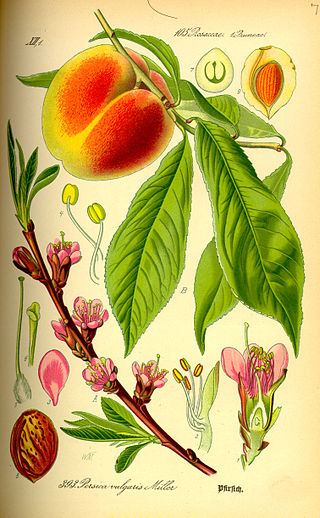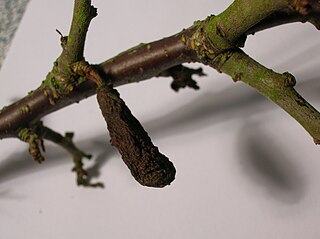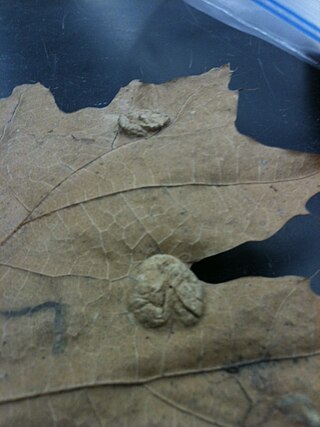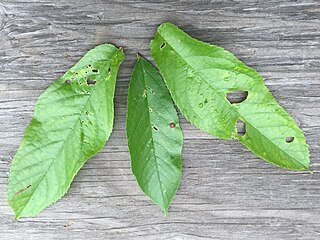
The peach is a deciduous tree first domesticated and cultivated in Zhejiang province of Eastern China. It bears edible juicy fruits with various characteristics, most called peaches and others, nectarines.

Black sigatoka is a leaf-spot disease of banana plants caused by the ascomycete fungus Mycosphaerella fijiensis (Morelet), also known as black leaf streak. It was discovered in 1963 and named for its similarities with yellow Sigatoka, which is caused by Mycosphaerella musicola (Mulder), which was itself named after the Sigatoka Valley in Fiji. In the same valley an outbreak of this disease reached epidemic proportions from 1912 to 1923.

Peach leaf curl is a plant disease characterized by distortion and coloration of leaves and is caused by the fungus Taphrina deformans, which infects peach, nectarine, and almond trees. T. deformans is found in the United States, Europe, Asia, Africa, Australia, and New Zealand. Peach leaf curl reduces the amount of leaves and fruit produced by peach and nectarine trees.

Uncinula necator is a fungus that causes powdery mildew of grape. It is a common pathogen of Vitis species, including the wine grape, Vitis vinifera. The fungus is believed to have originated in North America. European varieties of Vitis vinifera are more or less susceptible to this fungus. Uncinula necator infects all green tissue on the grapevine, including leaves and young berries. It can cause crop loss and poor wine quality if untreated. The sexual stage of this pathogen requires free moisture to release ascospores from its cleistothecia in the spring. However, free moisture is not needed for secondary spread via conidia; high atmospheric humidity is sufficient. Its anamorph is called Oidium tuckeri.

Venturia inaequalis is an ascomycete fungus that causes the apple scab disease.

Gymnosporangium juniperi-virginianae is a plant pathogen that causes cedar-apple rust. In virtually any location where apples or crabapples (Malus) and eastern red cedar coexist, cedar apple rust can be a destructive or disfiguring disease on both the apples and cedars. Apples, crabapples, and eastern red cedar are the most common hosts for this disease. Similar diseases can be found on quince and hawthorn and many species of juniper can substitute for the eastern red cedars.

Monilinia laxa is a plant pathogen that is the causal agent of brown rot of stone fruits.

Podosphaera leucotricha is a plant pathogen that can cause powdery mildew of apples and pears.

Oidium mangiferae is a plant pathogen that infects mango trees causing powdery mildew. Powdery mildew of mango is an Ascomycete pathogen of the Erysiphales family that was initially described by Berthet in 1914, using samples collected from Brazil. O. mangiferae is found in all areas where mangoes have been raised long term, but is particularly widespread in India where both the host and the pathogen are native. Currently no teleomorph stage has been identified, but due to certain morphological characteristics it has been suggested that O. mangiferae belongs in the Erysiphe polygony group. Mango is the only known host for this pathogen, though O. mangiferae appears to be identical to fungi responsible for powdery mildew diseases on various other plant species, particularly oak, though some differences may be observed. In particular, the number of cells in conidiophores varies from 2 on mango to 3-5 on oak. O. mangiferae has been known to infect oak leaves in the laboratory, however due to the lack of a known teleomorph stage O. mangiferae is still considered to only be a pathogen of mango. Recent analysis of its ribosomal DNA suggests it is conspecific with Erysiphe alphitoides, the causative agent of powdery mildew in European oaks.

Cercospora sojina is a fungal plant pathogen which causes frogeye leaf spot of soybeans. Frog eye leaf spot is a major disease on soybeans in the southern U.S. and has recently started to expand into the northern U.S. where soybeans are grown. The disease is also found in other soybean production areas of the world.

Dibotryon morbosum or Apiosporina morbosa is a plant pathogen, which is the causal agent of black knot. It affects members of the Prunus genus such as; cherry, plum, apricot, and chokecherry trees in North America. The disease produces rough, black growths that encircle and kill the infested parts, and provide habitat for insects.
Copper pesticides are copper compounds used as bactericides, algaecides, or fungicides. They can kill bacteria, oomycetes and algae, and prevent fungal spores from germinating. Common forms of fixed copper fungicides include copper sulfate, copper sulfate pentahydrate, copper hydroxide, copper oxychloride sulfate, cuprous oxide, and copper octanoate.

Taphrina pruni is a fungal plant pathogen of blackthorn that causes the pocket or bladder plum gall, a chemically induced distortion of the fruit (sloes), producing swollen on one side, otherwise deformed and flattened fruit gall without a stone. The twigs on infected plants may also be deformed with small strap-shaped leaves.

Taphrina caerulescens is a species of fungus in the family Taphrinaceae. It is a pathogenic Ascomycete fungus that causes oak leaf blister disease on various species of oak trees. The associated anamorph species is Lalaria coccinea, described in 1990. This disease causes lesions and blisters on Oak leaves. Effects of the disease are mostly cosmetic. Although not taxonomically defined, strains of T. caerulescens have been shown to be host specific with varying ¬ascus morphology between strains. There are differences in strains' abilities to metabolize various carbon and nitrogen compounds. This has been proposed as a method of taxonomically defining subspecies within T. caerulescens.
Leucostoma canker is a fungal disease that can kill stone fruit. The disease is caused by the plant pathogens Leucostoma persoonii and Leucostoma cinctum (teleomorph) and Cytospora leucostoma and Cytospora cincta (anamorphs). The disease can have a variety of signs and symptoms depending on the part of the tree infected. One of the most lethal symptoms of the disease are the Leucostoma cankers. The severity of the Leucostoma cankers is dependent on the part of the plant infected. The fungus infects through injured, dying or dead tissues of the trees. Disease management can consist of cultural management practices such as pruning, late season fertilizers or chemical management through measures such as insect control. Leucostoma canker of stone fruit can cause significant economic losses due to reduced fruit production or disease management practices. It is one of the most important diseases of stone fruit tree all over the world.
Peach scab, also known as peach freckles, is a disease of stone fruits caused by the fungi Cladosporium carpophilum. The disease is most prevalent in wet and warm areas especially southern part of the U.S. as the fungi require rain and wind for dispersal. The fungus causes scabbing, lesions, and defoliating on twig, fruit, and leaf resulting in downgrade of peach quality or loss of fruits due to rotting in severe cases.

Cherry leaf spot is a fungal disease which infects cherries and plums. Sweet, sour, and ornamental cherries are susceptible to the disease, being most prevalent in sour cherries. The variety of sour cherries that is the most susceptible are the English morello cherries. This is considered a serious disease in the Midwest, New England states, and Canada. It has also been estimated to infect 80 percent of orchards in the Eastern states. It must be controlled yearly to avoid a significant loss of the crop. If not controlled properly, the disease can dramatically reduce yields by nearly 100 percent. The disease is also known as yellow leaf or shothole disease to cherry growers due to the characteristic yellowing leaves and shot holes present in the leaves upon severe infection.

Pecan scab is the most economically significant disease of pecan trees in the southeastern United States. Venturia effusa is a fungal plant pathogen that causes pecan scab. The fungus causes lesions and tissue death on pecan twigs, petioles, leaves, nuts and shucks beginning in early spring, with multiple cycles of infection repeating until late summer. Wind and rain spread the fungus to a susceptible host. Control of the disease is achieved by fungicide, sanitation and, in some cases, quarantine.

Spilocaea oleaginea is a deuteromycete fungal plant pathogen, the cause of the disease olive peacock spot, also known as olive leaf spot and bird's eye spot. This plant disease commonly affects the leaves of olive trees worldwide. The disease affects trees throughout the growing season and can cause significant losses in yield. The disease causes blemishes on the fruit, delays ripening, and reduces the yield of oil. Defoliation and in severe cases, twig death, can occur, and the disease can have long-term health effects on the trees.

Shot hole disease is a serious fungal disease that creates BB-sized holes in leaves, rough areas on fruit, and concentric lesions on branches. The pathogen that causes shot hole disease is Wilsonomyces carpophilus.


















